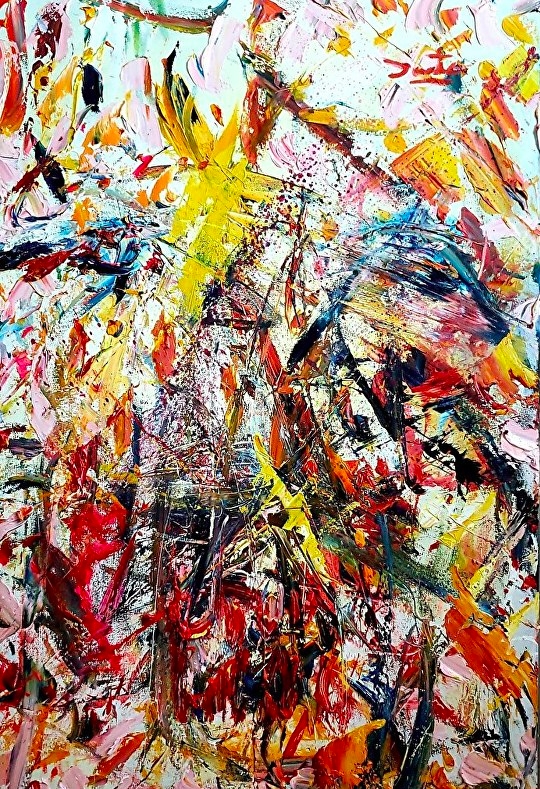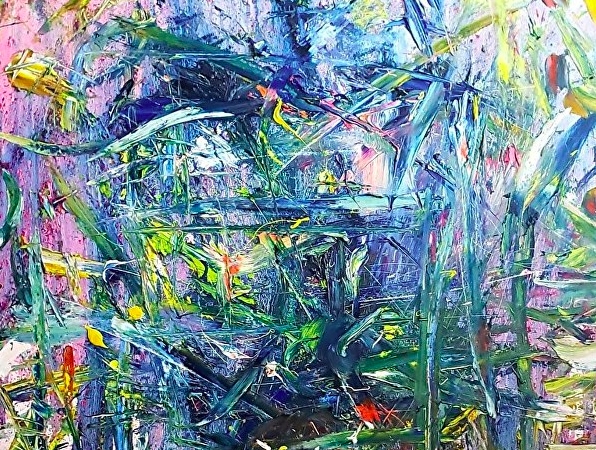The FAAM Four is a series of brief interviews with Indigenous artists across nations and disciplines.

Osage artist Dante Biss-Grayson’s large, vibrant abstract paintings attracted attention at this year’s SWAIA Indian Market. Arising from his experience as a combat veteran, the paintings are a departure from the artist’s former work. Biss-Grayson was born in Santa Fe. He writes that he “grew up as the apprentice/protégé and son of [artists]Earl Biss and Gina Gray,” surrounded by the radical art of 1960s/70s-era Institute of American Indian Arts.
Biss-Grayson joined the US Armed Forces shortly after the turn of the century. After multiple combat tours, he found that art, specifically Abstract Expressionism, is one way he can cope with the resulting PTSD. His bio explains that he approaches each piece as a “vision quest,” and that “instead of using sharp edges for self-healing, he turned these edges onto the canvas, where he found Abstract Expressionism as the best platform to express the multitude of traumas that he had to endure.” He writes that art is a “savior” and has been the way he seeks his post-combat identity, creating a series of 22 numbered canvases based on individual traumatic events. (The number 22 refers to the commonly cited statistic that 22 veterans a day are lost to suicide.)
“Finding an ‘identity,’ after a war is difficult,” the artist writes. “As the numbers show, many veterans simply cannot deal with life after what they have seen. … By using art as a conduit to process and convey the brutal emotions that are felt, remembered, and which trigger massive panic attacks, the pain is externalized. In this way, a completed process is achieved. While this is not perfect, it is one way in which veterans can achieve a new sense of ‘Identity’.”
Whose art is interesting/inspiring to you right now?
Opera has been inspiring me lately. Specifically, La Boheme by Puccini and La Traviata by Verdi, and Southern Plains War Drums. The music is played loud in the studio, set on random, and helps me connect to the tragedy of war. Somehow I have been holding back my emotions of thoughts of the war, but now, I have found a way to completely release the traumas. Odd Nerdum, Earl Biss, and Willem de Kooning have been recent visual artists that are inspiring me.
What are you working on right now?

Current projects: Homage series to my inspiration and father, Earl Biss. Documentary in development about Earl Biss. Gallery show at Agora Gallery in New York City, May 11, 2019. And a December show with SWAIA.
Working on digital projection 3D series of vision quest, where I am trying to convey a 3D immersion installation of the spirit worlds. Charcoal drawing series of specific traumas in a classic chiaroscuro light influenced by dream-like qualities and Northern Europe influence. Dark Blue Series of native riders before the hunt.
And, an archetype series of cave painting with modern influences. But this was all before I found the New-Post War Abstract Expressionism, so, I am not sure. It may be difficult to change my palette, as I feel I have found my true form of expression. We shall see after 100 paintings.
What is the best advice you’ve received as an artist?
Don’t take no shit from nobody! Be yourself, and do what makes you free! Earl Biss while we were in the Aspen Studio.
Where can people find your work?
On Twitter, @dantebissgray and at two websites: This one from ARTmine (Agora Gallery) and my personal site.
